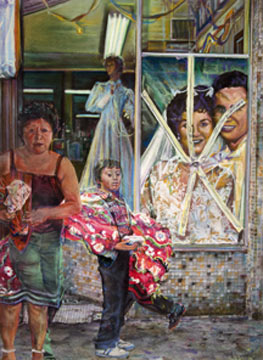
The timing could hardly be better for the all-new 40,000 square foot Vincent Price Museum to finally open its doors to the public this month. The centerpiece of the new $89 million Performing and Fine Arts Center of East Los Angeles College, this beautiful three-story museum is poised to be a real art player in LA. With the all the buzz about “Pacific Standard Time,” the huge southern Californian collaboration involving more than 60 cultural institutions investigating the birth of the Los Angeles art scene coming this fall, curator Karen Rapp’s “Roundtrip: Eight ELAC Alumni Artists” provides a welcome early counterpoint and balance to a story that is all too often dominated by international hotshots like Ruscha and Baldessari.
Each of the eight featured artists not only attended ELAC, but were profoundly influenced by their education and time there; many of them even recall Vincent Price himself, who by many accounts was an enthusiastic and frequent visitor to the campus art studios and classes. It was Price and his wife, Mary Grant, who championed the arts and first-hand arts learning in this once arts-poor area of town. It was their original donation of ninety pieces from their personal collection in 1957 that established the first teaching art collection housed at a two-year community college in the nation. That gift, nourished and well-tended, has grown into today’s astonishing 8,000+-piece collection, which is still primarily organized for the use of the local community and students.
While Rapp acknowledges that the works in the exhibition will create dialogues between pieces, she envisioned it as a series of mini-retrospectives, with each artist having their own section of representative work. The work from the early years, usually just post-graduate for these mid-career artists, is mostly wall-based, figurative, and political. Their work of the last decade broadens to include video, sculpture, and installation, and while frequently political, it has become more abstract. “Roundtrip” fills in missing bits of southland art historical information, as well as reflecting a community and street-based inclination, sometimes fueled by anger and outrage, of this east LA-educated group.
We recognize Kent Twitchell’s work from the mural of the LA Chamber Orchestra along the three nine-story walls overlooking the northbound 110; and from the LA Marathon mural, now on the southbound side of the 5 Freeway. Active as a muralist and grand scale portrait artist since the late 60’s, Twitchell’s selections document his mural history, including a large diptych of John Kennedy and Ronald Reagan, which was originally a part of the Wende Museum’s “Berlin Wall Project” installed along Wilshire Boulevard in 2009; and his portrait of Ed Ruscha, the multi-storey mural of whom was painted over and destroyed in 2006.
Gronk’s signature “wall graffiti,” which are like “anti-blackboards,” include black backgrounds with scribbles detailing obscure creative impulses rather than logical scientific notations. Also included are selections of his sculpture and early black and white photographs. These prints have never been exhibited before and will provide a sneak preview to the upcoming ASCO exhibition opening in the fall at LACMA. Gronk was a member of that four person Chicano performance and conceptual art collective active during the 70’s and 80’s. He was one of its founding members, along with Harry Gamboa, Jr, Willie Herron and Patssi Valdez (the last two are also ELAC alum included in the show).
Diane Gamboa, who also participated in ASCO, has a series of portraits on display. Radiating not an insignificant amount of tense hostility, these bold portraits of unnamed women on collaged leopard print backgrounds display a terse strength, grace, and animal sexuality. Thick black lines outline blue muscled bodies, the hair is flaming, and there is always jewelry, even when the figures are nude. On the lighter side, there will be 24 of her smaller more eccentric paintings from the early 90’s.
And lest you think this part of East L.A. is wholly Chicano – it’s not – there is also a nod to the adjacent Asian community down Atlantic street. Clement Hamani, whose mother is an atomic bomb survivor (a horrifyingly relevant detail today) will have two installations on display, along with his not-so-innocent “Dick and Jane” paintings. Other artists in the show include Judithe Hernández and Willy Herrón III.
Viewers will find that there is a gritty and substantively personal tone to the show. The colors are vivid, sometimes garish, and the feeling of people on the streets looms large. Quiet and powerful moments appear throughout; be sure not to miss John Valadez’s full-size pastel on paper portraits. “The Preacher” (1984), shown here for the first time, is stunning in its lyric portrayal of a man at Pershing Square.
Published courtesy of ArtSceneCal ©2011
